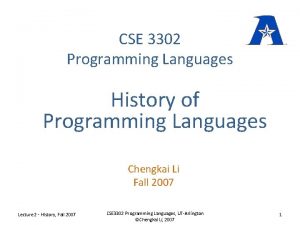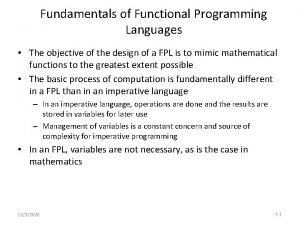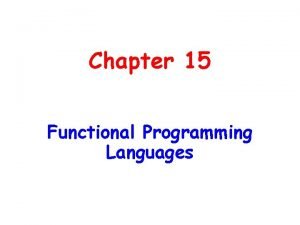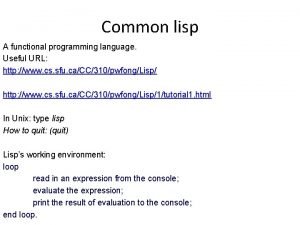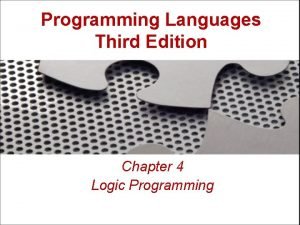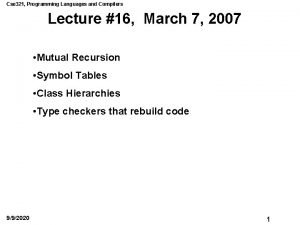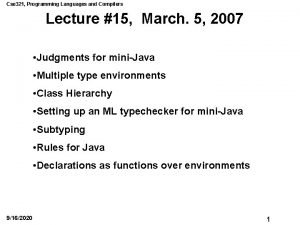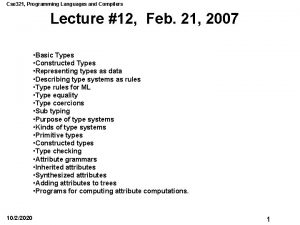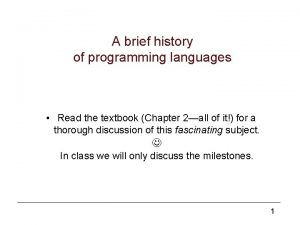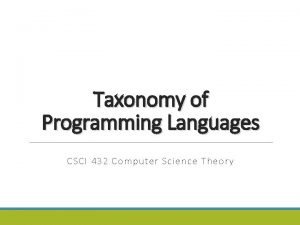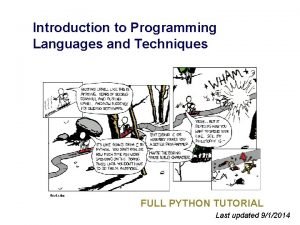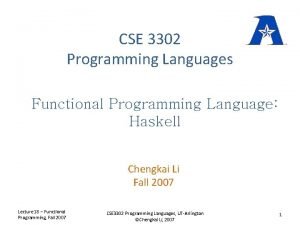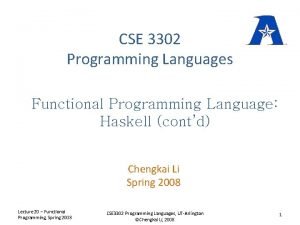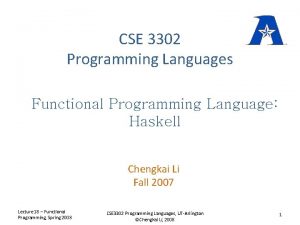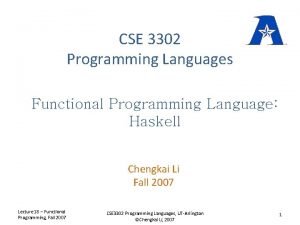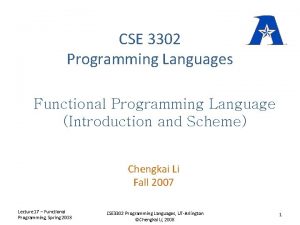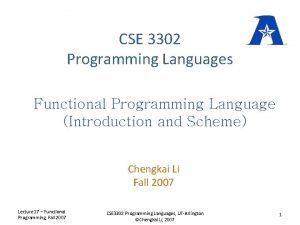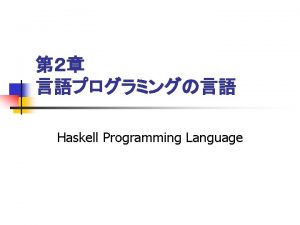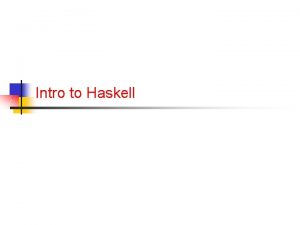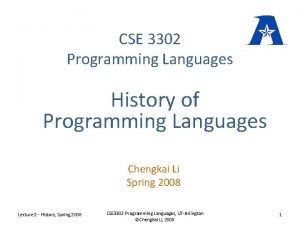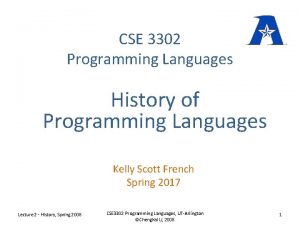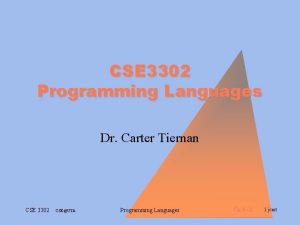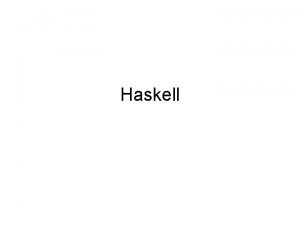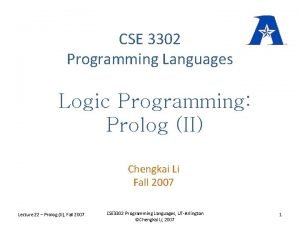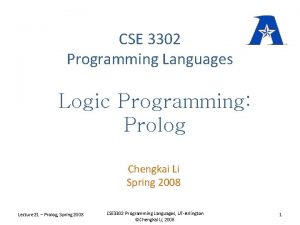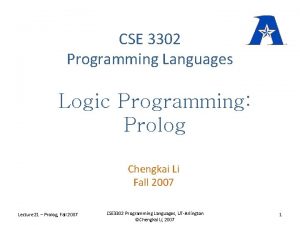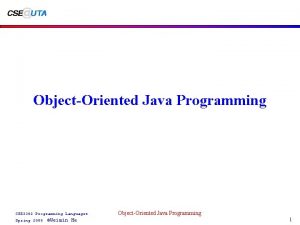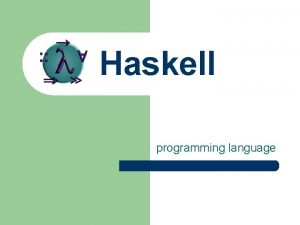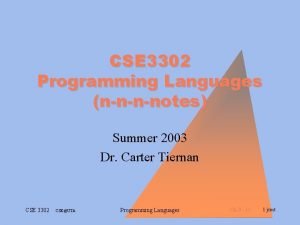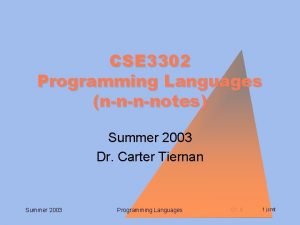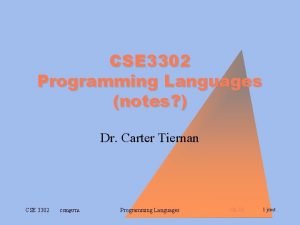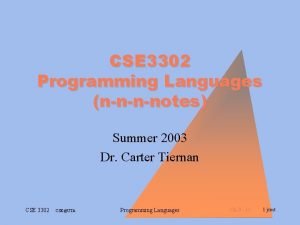CSE 3302 Programming Languages Functional Programming Language Haskell




![Generators z The expression x [1. . 5] is called a generator, as it Generators z The expression x [1. . 5] is called a generator, as it](https://slidetodoc.com/presentation_image_h2/d42d6e708c4018d4a061bdad00f13afe/image-5.jpg)





![prime : : Int -> Bool prime n = factors n == [1, n] prime : : Int -> Bool prime n = factors n == [1, n]](https://slidetodoc.com/presentation_image_h2/d42d6e708c4018d4a061bdad00f13afe/image-11.jpg)
![primes : : Int -> [Int] primes n = [x | x <- [1. primes : : Int -> [Int] primes n = [x | x <- [1.](https://slidetodoc.com/presentation_image_h2/d42d6e708c4018d4a061bdad00f13afe/image-12.jpg)




![For example: product [1, 2, 3] = product (1: (2: (3: []))) = 1 For example: product [1, 2, 3] = product (1: (2: (3: []))) = 1](https://slidetodoc.com/presentation_image_h2/d42d6e708c4018d4a061bdad00f13afe/image-17.jpg)

![++ is list concatenation qsort : : [Int] -> [Int] qsort [] = [] ++ is list concatenation qsort : : [Int] -> [Int] qsort [] = []](https://slidetodoc.com/presentation_image_h2/d42d6e708c4018d4a061bdad00f13afe/image-19.jpg)







![For example: sum [] = 0 sum (x: xs) = x + sum xs For example: sum [] = 0 sum (x: xs) = x + sum xs](https://slidetodoc.com/presentation_image_h2/d42d6e708c4018d4a061bdad00f13afe/image-27.jpg)

![foldr makes right-associative foldl makes left-associative foldr (-) 1 [2, 3, 4] foldl (-) foldr makes right-associative foldl makes left-associative foldr (-) 1 [2, 3, 4] foldl (-)](https://slidetodoc.com/presentation_image_h2/d42d6e708c4018d4a061bdad00f13afe/image-29.jpg)
- Slides: 29

CSE 3302 Programming Languages Functional Programming Language: Haskell (cont’d) Chengkai Li Fall 2007 Lecture 19 – Functional Programming, Fall 2007 CSE 3302 Programming Languages, UT-Arlington ©Chengkai Li, 2007 1

List Comprehensions Lecture 19 – Functional Programming, Fall 2007 CSE 3302 Programming Languages, UT-Arlington ©Chengkai Li, 2007 2

List Comprehension • For list with elements of type in the Enum class (Int, Char, …) > [1. . 10] [1, 2, 3, 4, 5, 6, 7, 8, 9, 10] Lecture 19 – Functional Programming, Fall 2007 CSE 3302 Programming Languages, UT-Arlington ©Chengkai Li, 2007 3

Lists Comprehensions List comprehension can be used to construct new lists from old lists. In mathematical form {f(x) | x s p(x)} [x^2 | x <- [1. . 5]] i. e. , { x^2 | x [1. . 10]} The list [1, 4, 9, 16, 25] of all numbers x^2 such that x is an element of the list [1. . 5]. Lecture 19 – Functional Programming, Fall 2007 CSE 3302 Programming Languages, UT-Arlington ©Chengkai Li, 2007 4
![Generators z The expression x 1 5 is called a generator as it Generators z The expression x [1. . 5] is called a generator, as it](https://slidetodoc.com/presentation_image_h2/d42d6e708c4018d4a061bdad00f13afe/image-5.jpg)
Generators z The expression x [1. . 5] is called a generator, as it states how to generate values for x. z Comprehensions can have multiple generators, separated by commas. For example: > [(x, y) | x <- [1. . 3], y <- [1. . 2]] [(1, 1), (1, 2), (2, 1), (2, 2), (3, 1), (3, 2)] Lecture 19 – Functional Programming, Fall 2007 CSE 3302 Programming Languages, UT-Arlington ©Chengkai Li, 2007 5

Order Matters z Changing the order of the generators changes the order of the elements in the final list: > [(x, y) | y <- [1. . 2], x <- [1. . 3]] [(1, 1), (2, 1), (3, 1), (1, 2), (2, 2), (3, 2)] z Multiple generators are like nested loops, with later generators as more deeply nested loops whose variables change value more frequently. Lecture 19 – Functional Programming, Fall 2007 CSE 3302 Programming Languages, UT-Arlington ©Chengkai Li, 2007 6

Dependant Generators Later generators can depend on the variables that are introduced by earlier generators. [(x, y) | x <- [1. . 3], y <- [x. . 3]] The list [(1, 1), (1, 2), (1, 3), (2, 2), (2, 3), (3, 3)] of all pairs of numbers (x, y) such that x, y are elements of the list [1. . 3] and x y. Lecture 19 – Functional Programming, Fall 2007 CSE 3302 Programming Languages, UT-Arlington ©Chengkai Li, 2007 7

Using a dependant generator we can define the library function that concatenates a list of lists: concat : : [[a]] -> [a] concat xss = [x | xs <- xss, x <- xs] For example: > concat [[1, 2, 3], [4, 5], [6]] [1, 2, 3, 4, 5, 6] Lecture 19 – Functional Programming, Fall 2007 CSE 3302 Programming Languages, UT-Arlington ©Chengkai Li, 2007 8

Guards List comprehensions can use guards to restrict the values produced by earlier generators. [x | x <- [1. . 10], even x] The list [2, 4, 6, 8, 10] of all numbers x such that x is an element of the list [1. . 10] and x is even. Lecture 19 – Functional Programming, Fall 2007 CSE 3302 Programming Languages, UT-Arlington ©Chengkai Li, 2007 9

Using a guard we can define a function that maps a positive integer to its list of factors: factors : : Int -> [Int] factors n = [x | x <- [1. . n] , n `mod` x == 0] For example: > factors 15 [1, 3, 5, 15] Lecture 19 – Functional Programming, Fall 2007 CSE 3302 Programming Languages, UT-Arlington ©Chengkai Li, 2007 10
![prime Int Bool prime n factors n 1 n prime : : Int -> Bool prime n = factors n == [1, n]](https://slidetodoc.com/presentation_image_h2/d42d6e708c4018d4a061bdad00f13afe/image-11.jpg)
prime : : Int -> Bool prime n = factors n == [1, n] For example: > prime 15 False > prime 7 True Lecture 19 – Functional Programming, Fall 2007 CSE 3302 Programming Languages, UT-Arlington ©Chengkai Li, 2007 11
![primes Int Int primes n x x 1 primes : : Int -> [Int] primes n = [x | x <- [1.](https://slidetodoc.com/presentation_image_h2/d42d6e708c4018d4a061bdad00f13afe/image-12.jpg)
primes : : Int -> [Int] primes n = [x | x <- [1. . n], prime x] For example: > primes 40 [2, 3, 5, 7, 11, 13, 17, 19, 23, 29, 31, 37] Lecture 19 – Functional Programming, Fall 2007 CSE 3302 Programming Languages, UT-Arlington ©Chengkai Li, 2007 12

Recursive Functions Lecture 19 – Functional Programming, Fall 2007 CSE 3302 Programming Languages, UT-Arlington ©Chengkai Li, 2007 13

factorial 0 = 1 factorial n = n * factorial (n-1) factorial maps 0 to 1, and any other integer to the product of itself with the factorial of its predecessor. Lecture 19 – Functional Programming, Fall 2007 CSE 3302 Programming Languages, UT-Arlington ©Chengkai Li, 2007 14

For example: factorial 3 = 3 * factorial 2 = 3 * (2 * factorial 1) = 3 * (2 * (1 * factorial 0)) = 3 * (2 * (1 * 1)) = 3 * (2 * 1) = 3 * 2 = 6 Lecture 19 – Functional Programming, Fall 2007 CSE 3302 Programming Languages, UT-Arlington ©Chengkai Li, 2007 15

Recursion on Lists Recursion is not restricted to numbers, but can also be used to define functions on lists. product : : [Int] -> Int product [] = 1 product (x: xs) = x * product xs product maps the empty list to 1, and any non-empty list to its head multiplied by the product of its tail. Lecture 19 – Functional Programming, Fall 2007 CSE 3302 Programming Languages, UT-Arlington ©Chengkai Li, 2007 16
![For example product 1 2 3 product 1 2 3 1 For example: product [1, 2, 3] = product (1: (2: (3: []))) = 1](https://slidetodoc.com/presentation_image_h2/d42d6e708c4018d4a061bdad00f13afe/image-17.jpg)
For example: product [1, 2, 3] = product (1: (2: (3: []))) = 1 * product (2: (3: [])) = 1 * (2 * product (3: [])) = 1 * (2 * (3 * product [])) = 1 * (2 * (3 * 1)) = 6 Lecture 19 – Functional Programming, Fall 2007 CSE 3302 Programming Languages, UT-Arlington ©Chengkai Li, 2007 17

Quicksort The quicksort algorithm for sorting a list of integers can be specified by the following two rules: z The empty list is already sorted; z Non-empty lists can be sorted by sorting the tail values the head, and then appending the resulting lists on either side of the head value. Lecture 19 – Functional Programming, Fall 2007 CSE 3302 Programming Languages, UT-Arlington ©Chengkai Li, 2007 18
![is list concatenation qsort Int Int qsort ++ is list concatenation qsort : : [Int] -> [Int] qsort [] = []](https://slidetodoc.com/presentation_image_h2/d42d6e708c4018d4a061bdad00f13afe/image-19.jpg)
++ is list concatenation qsort : : [Int] -> [Int] qsort [] = [] qsort (x: xs) = qsort [a | a <- xs, a <= x] ++ [x] ++ qsort [b | b <- xs, b x] z This is probably the simplest implementation of quicksort in any programming language! Lecture 19 – Functional Programming, Fall 2007 CSE 3302 Programming Languages, UT-Arlington ©Chengkai Li, 2007 19

Higher-Order Functions Lecture 19 – Functional Programming, Fall 2007 CSE 3302 Programming Languages, UT-Arlington ©Chengkai Li, 2007 20

Introduction A function is called higher-order if it takes a function as an argument or returns a function as a result. twice : : (a -> a) -> a twice f x = f (f x) twice is higher-order because it takes a function as its first argument. Lecture 19 – Functional Programming, Fall 2007 CSE 3302 Programming Languages, UT-Arlington ©Chengkai Li, 2007 21

The Map Function The higher-order library function called map applies a function to every element of a list. map : : (a -> b) -> [a] -> [b] For example: > map factorial [1, 3, 5] [1, 6, 120] Lecture 19 – Functional Programming, Fall 2007 CSE 3302 Programming Languages, UT-Arlington ©Chengkai Li, 2007 22

The map function can be defined in a particularly simple manner using a list comprehension: map f xs = [f x | x <- xs] Alternatively, for the purposes of proofs, the map function can also be defined using recursion: map f [] = [] map f (x: xs) = f x : map f xs Lecture 19 – Functional Programming, Fall 2007 CSE 3302 Programming Languages, UT-Arlington ©Chengkai Li, 2007 23

The Filter Function The higher-order library function filter selects every element from a list that satisfies a predicate. filter : : (a -> Bool) -> [a] For example: > filter even [1. . 10] [2, 4, 6, 8, 10] Lecture 19 – Functional Programming, Fall 2007 CSE 3302 Programming Languages, UT-Arlington ©Chengkai Li, 2007 24

Filter can be defined using a list comprehension: filter p xs = [x | x <- xs, p x] Alternatively, it can be defined using recursion: filter p [] = [] filter p (x: xs) Lecture 19 – Functional Programming, Fall 2007 | p x = x : filter p xs | otherwise = filter p xs CSE 3302 Programming Languages, UT-Arlington ©Chengkai Li, 2007 25

The Foldr Function A number of functions on lists can be defined using the following simple pattern of recursion: f [] = v f (x: xs) = x f xs f maps the empty list to a value v, and any non-empty list to a function applied to its head and f of its tail. Lecture 19 – Functional Programming, Fall 2007 CSE 3302 Programming Languages, UT-Arlington ©Chengkai Li, 2007 26
![For example sum 0 sum x xs x sum xs For example: sum [] = 0 sum (x: xs) = x + sum xs](https://slidetodoc.com/presentation_image_h2/d42d6e708c4018d4a061bdad00f13afe/image-27.jpg)
For example: sum [] = 0 sum (x: xs) = x + sum xs v=0 =+ product [] = 1 product (x: xs) = x * product xs and [] = True and (x: xs) = x && and xs Lecture 19 – Functional Programming, Fall 2007 v=1 =* v = True = && CSE 3302 Programming Languages, UT-Arlington ©Chengkai Li, 2007 27

The higher-order library function foldr (“fold right”) encapsulates this simple pattern of recursion, with the function and the value v as arguments. For example: sum = foldr (+) 0 product = foldr (*) 1 and Lecture 19 – Functional Programming, Fall 2007 = foldr (&&) True CSE 3302 Programming Languages, UT-Arlington ©Chengkai Li, 2007 28
![foldr makes rightassociative foldl makes leftassociative foldr 1 2 3 4 foldl foldr makes right-associative foldl makes left-associative foldr (-) 1 [2, 3, 4] foldl (-)](https://slidetodoc.com/presentation_image_h2/d42d6e708c4018d4a061bdad00f13afe/image-29.jpg)
foldr makes right-associative foldl makes left-associative foldr (-) 1 [2, 3, 4] foldl (-) 1 [2, 3, 4] (section 3. 3. 2 in the tutorial) Lecture 19 – Functional Programming, Fall 2007 CSE 3302 Programming Languages, UT-Arlington ©Chengkai Li, 2007 29
 Cse 3302
Cse 3302 Adam doupe cse 340
Adam doupe cse 340 Vineeth kashyap
Vineeth kashyap Fundamentals of functional programming language
Fundamentals of functional programming language Fundamentals of functional programming language
Fundamentals of functional programming language Is lisp a functional programming language
Is lisp a functional programming language Real-time systems and programming languages
Real-time systems and programming languages Cs 421 uiuc
Cs 421 uiuc Real time example of multithreading in java
Real time example of multithreading in java Cxc it
Cxc it Introduction to programming languages
Introduction to programming languages Plc programming languages
Plc programming languages Joey paquet
Joey paquet Comparative programming languages
Comparative programming languages Alternative programming languages
Alternative programming languages Strongly typed vs weakly typed
Strongly typed vs weakly typed Transmission programming languages
Transmission programming languages Integral data types
Integral data types Xenia programming languages
Xenia programming languages Advantages and disadvantages of system software
Advantages and disadvantages of system software Mainstream programming languages
Mainstream programming languages Programing languages
Programing languages Programming languages
Programming languages Programming languages
Programming languages Programming languages
Programming languages Tiny programming language
Tiny programming language Brief history of programming languages
Brief history of programming languages Lisp_q
Lisp_q Real time programming language
Real time programming language Xkcd programming languages
Xkcd programming languages
